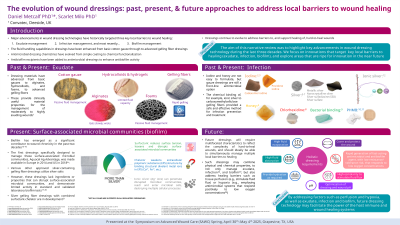Practice Innovations
(PI-030) The Evolution of Wound Dressings: Past, Present, and Future Approaches to Address Local Barriers to Wound Healing
Friday, May 2, 2025
7:45 PM - 8:45 PM East Coast USA Time

Daniel Metcalf, PhD – Director, Advanced Wound Care R&D, Convatec Ltd
Introduction: Hard-to-heal wounds, such as leg ulcers and diabetic foot ulcers, are highly prevalent and place a significant burden on patients and healthcare systems. The aim of this review was to describe a next stage of the evolution of advanced dressings for the treatment of hard-to-heal wounds.
Methods: Narrative review.
Results: Major developments in dressing technologies in the last three or four decades have focused on key local barriers to wound healing: (1) exudate management, (2) infection management, and most recently, (3) management of biofilm (surface-associated and aggregated microbial communities). Past approaches have focused on dressing physical and chemical characteristics designed to manage exudate and infection. For example, material advances in alginates, hydrocolloids and advanced gelling fibers have provided clinically useful material properties for the management of moderately to highly exuding wounds. Furthermore, the addition of, for example, ionic silver to such dressings* provided a safe and effective method for management of microbial colonization and local infection. More recently, biofilm has been inexorably linked to hard-to-heal wounds. A present ‘state of the art’ dressing is the first of its kind designed to manage, in addition to exudate and local infection risk, surface-associated and aggregated microbial communities within the dressing**, utilizing additional excipients to penetrate microbial extracellular polymeric substances and facilitate the antimicrobial effects of ionic silver.
Discussion: Future approaches will require next-generation wound dressings to enhance and expand the management of the above local barriers to wound healing. By addressing factors such as poorly-perfused tissue and hypoxia, dressing technology can potentially facilitate the power of the host immune and wound healing systems. A novel prototype nitric oxide-generating dressing technology*** combines physical and chemical properties to not only manage exudate, infection and surface-associated/aggregated microbial communities within the dressing, but also to potentially address tissue perfusion and hypoxia by physical means, to improve wound healing outcomes. Enhanced physical and chemical dressing characteristics (fluid absorption and donation, continuous moisture vapor transmission rate, pH), also impart an environment that is inhospitable to pathogens and development of surface-associated and aggregated microbial communities.
Methods: Narrative review.
Results: Major developments in dressing technologies in the last three or four decades have focused on key local barriers to wound healing: (1) exudate management, (2) infection management, and most recently, (3) management of biofilm (surface-associated and aggregated microbial communities). Past approaches have focused on dressing physical and chemical characteristics designed to manage exudate and infection. For example, material advances in alginates, hydrocolloids and advanced gelling fibers have provided clinically useful material properties for the management of moderately to highly exuding wounds. Furthermore, the addition of, for example, ionic silver to such dressings* provided a safe and effective method for management of microbial colonization and local infection. More recently, biofilm has been inexorably linked to hard-to-heal wounds. A present ‘state of the art’ dressing is the first of its kind designed to manage, in addition to exudate and local infection risk, surface-associated and aggregated microbial communities within the dressing**, utilizing additional excipients to penetrate microbial extracellular polymeric substances and facilitate the antimicrobial effects of ionic silver.
Discussion: Future approaches will require next-generation wound dressings to enhance and expand the management of the above local barriers to wound healing. By addressing factors such as poorly-perfused tissue and hypoxia, dressing technology can potentially facilitate the power of the host immune and wound healing systems. A novel prototype nitric oxide-generating dressing technology*** combines physical and chemical properties to not only manage exudate, infection and surface-associated/aggregated microbial communities within the dressing, but also to potentially address tissue perfusion and hypoxia by physical means, to improve wound healing outcomes. Enhanced physical and chemical dressing characteristics (fluid absorption and donation, continuous moisture vapor transmission rate, pH), also impart an environment that is inhospitable to pathogens and development of surface-associated and aggregated microbial communities.

.jpg)